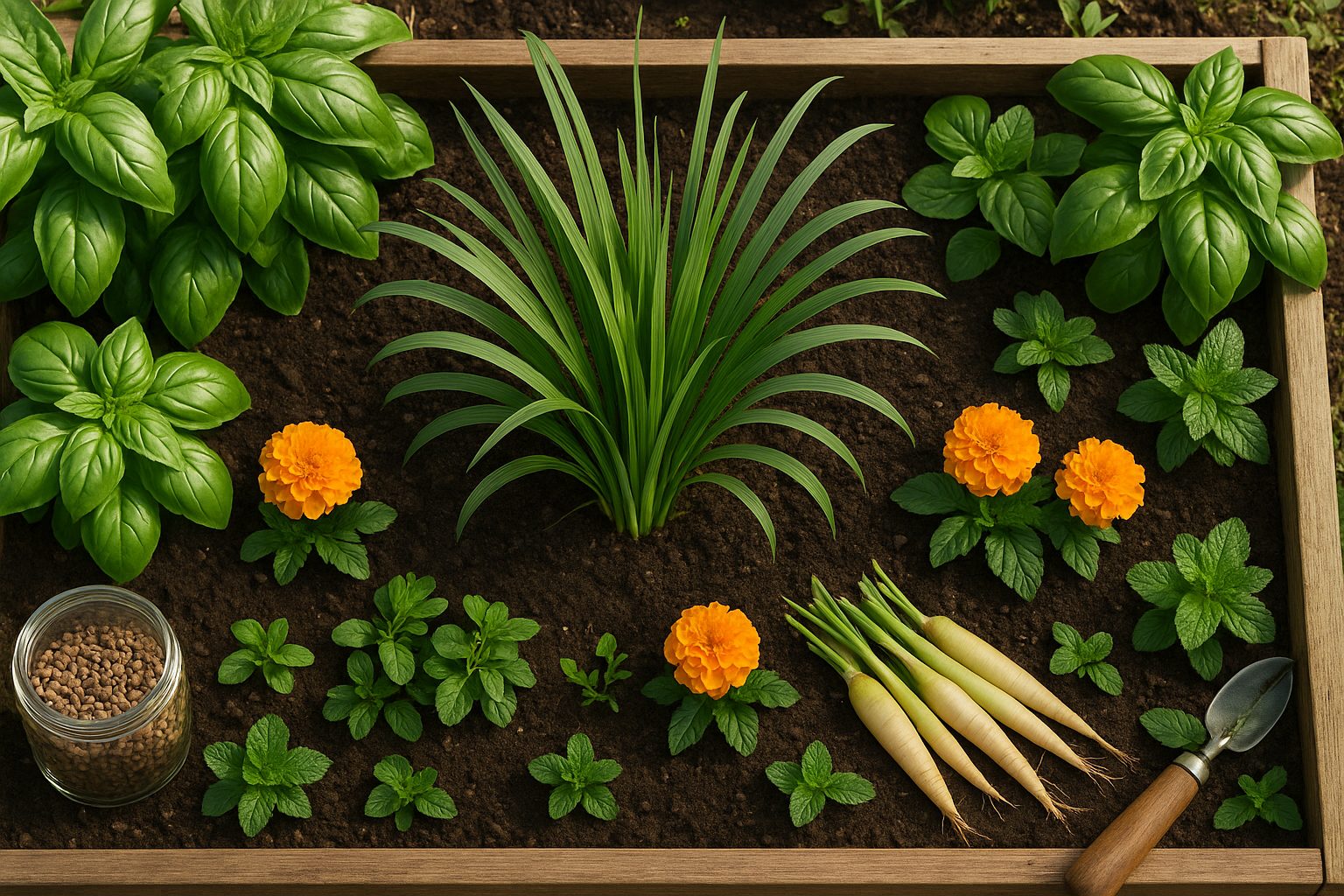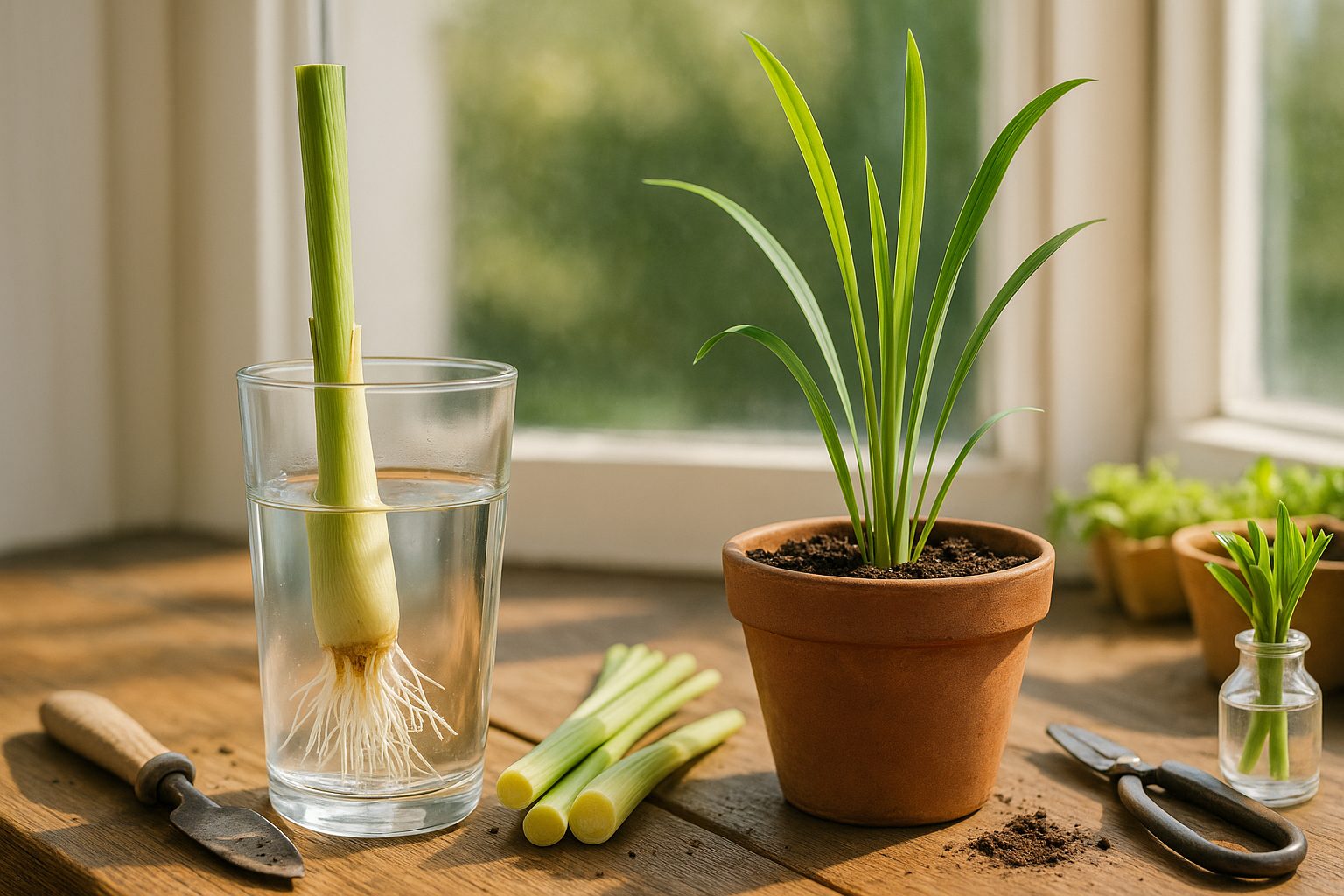Companion Planting & Benefits

If you’re thinking about growing lemongrass in raised beds, companion planting is a smart strategy that can take your harvest to the next level. This gardening approach involves grouping plants together so they help each other thrive—boosting growth, improving flavor, and naturally fending off pests.
For lemongrass, certain companions make all the difference. Try planting basil nearby; its aromatic leaves not only repel insects but also help create a microclimate lemongrass loves. Mint is another great partner. Its rapid growth shades the soil and keeps it moist, something lemongrass roots appreciate. Plus, both basil and mint can deter common pests such as aphids and mosquitoes, reducing the need for chemical sprays.
Marigolds are garden superstars too. Their bright flowers attract beneficial insects like ladybugs, while their strong scent confuses pests that might otherwise feast on your lemongrass. This dynamic trio—lemongrass, basil, and marigolds—works together for a naturally healthier, more productive bed.
But not all plants are good neighbors. Avoid planting lemongrass near tall, greedy growers like corn, which can block the sun, or water-hungry vegetables like cucumbers, which compete for precious moisture. Alliums like garlic and onions aren’t the best choice either; their strong root systems can crowd out lemongrass and stunt its growth. Stick to tried-and-true companions, and your lemongrass in raised beds will reward you with vigorous, fragrant stalks all season long.
How to Grow Lemongrass

Lemongrass thrives in warm, sunny environments, so choose a spot that gets at least six hours of direct sunlight daily—outdoors is ideal, but indoor plants do well on a bright windowsill. This tropical herb prefers temperatures above 60°F (15°C); if you live in a cooler climate, bring potted lemongrass indoors during chilly months.
For best results, plant lemongrass in well-draining, loamy soil enriched with compost, keeping the pH neutral to slightly acidic. Water regularly to keep the soil consistently moist but not waterlogged—lemongrass doesn’t like soggy feet.
Starting Lemongrass
To start from a stalk, buy a fresh, healthy lemongrass stalk from the store, trim the top, and place it in a glass of water with the base submerged; roots should form within a week or two. Once roots are at least an inch long, transplant the stalk into soil either outdoors or in a roomy pot.
If dividing mature clumps, gently separate the roots and plant each division in its own hole about 2 feet apart.
Lemongrass seeds are less common but can be sown indoors: scatter seeds on moist soil, cover lightly, and maintain warmth and humidity until seedlings appear.
Care Tips
- Outdoors, mulch around the plants to retain moisture and suppress weeds.
- Indoors, choose a large, well-draining pot and avoid drafty spots.
- Rotate potted plants occasionally to ensure even growth.
- Feed lemongrass monthly with a balanced liquid fertilizer during the growing season to encourage lush, aromatic stalks ready for harvest.
This versatile approach means you can enjoy fresh lemongrass year-round, whether your garden space is a backyard plot or a sunny kitchen corner.
Caring for Lemongrass
Caring for lemongrass is simple when you stick to a routine that keeps this tropical herb happy. Water lemongrass consistently, making sure the soil stays moist but not soggy—water every few days in hot weather, and let the top inch dry slightly in cooler months.
Lemongrass is a fast grower, so feed it every four to six weeks with a balanced liquid fertilizer during the active growing season for lush, flavorful stalks. Regular pruning is key: snip older, woody stalks at the base to encourage new growth and prevent overcrowding.
If you spot yellowing leaves, it usually points to underwatering, nutrient deficiencies, or poorly draining soil—adjust your care accordingly and trim away any damaged bits. Keep an eye out for pests like aphids or spider mites; a strong spray of water or a gentle soap solution usually keeps them in check.
Fungal diseases can appear if humidity and airflow are poor, so avoid wetting the leaves and give the plant plenty of space. In colder climates, lemongrass won’t survive harsh winters outdoors. Dig up clumps in fall and pot them up for a sunny windowsill, or trim the stalks and keep the roots just barely moist in a cool, frost-free place until spring.
With this routine, your lemongrass should thrive, adding fresh flavor to your kitchen year after year.
Harvesting and Storing Lemongrass
The best time to harvest lemongrass is when the stalks reach at least half an inch thick, usually about four to six months after planting. To harvest, use a sharp knife or garden shears to cut the stalks near the base, choosing the firmest, pale lower stems.
For immediate use, rinse and trim the roots and tough, outer leaves.
To store lemongrass fresh, wrap cleaned stalks in a damp paper towel and place them inside a resealable bag in your refrigerator—they’ll stay crisp for up to two weeks. For longer storage, you can freeze whole or sliced stalks: seal them in freezer bags, and they’ll retain their flavor for up to six months.
Drying is another option; cut the stalks into short pieces and let them air-dry in a shaded, well-ventilated spot, or use a dehydrator. Once dried, store them in an airtight container away from light.
If you’d like to grow more lemongrass, select healthy stalks, trim leaves and roots, and place the base in a glass of water until roots develop; then, transplant into soil to propagate new plants. This way, you’ll always have a fresh supply on hand!
Culinary and Wellness Uses
Lemongrass is a versatile herb that brings a citrusy aroma and fresh flavor to numerous dishes, making it a popular ingredient in Southeast Asian cooking. Home cooks love adding it to curries, soups like Tom Yum, and even simple stir-fries for that unmistakable zest.
For tea, just trim the root and woody leaves, then bruise the stalks with the back of your knife to release their essential oils—steep in hot water for a soothing, fragrant infusion. In savory dishes, slice thin rounds for sautéing, or crush and add whole pieces to simmering broths, removing them before serving.
Beyond its culinary appeal, lemongrass tea is famous for aiding digestion and promoting relaxation, thanks to its natural oils and antioxidants. Many people also use lemongrass as a home remedy for bloating or mild stomach discomfort—simply prepare a cup by steeping fresh or dried stalks, and sip slowly.
Whether you’re elevating a curry or looking for a gentle herbal aid, incorporating lemongrass into your kitchen routine can offer both vibrant flavors and wellness benefits.
Lemongrass as a Natural Garden Ally
Lemongrass is more than just a flavorful herb for your kitchen—it’s a powerful, natural ally in the garden. Thanks to its strong citrus scent, lemongrass helps repel common pests like mosquitoes, whiteflies, and aphids, making it a perfect choice for organic gardeners who want to avoid synthetic chemicals.
This hardy, fast-growing grass adds a tropical flair to any space with its tall, elegant stalks and vibrant green foliage. Lemongrass thrives equally well in beds or large containers, letting you move it around or even bring it indoors during colder months.
For an eye-catching and functional planting scheme, try pairing lemongrass with flowering herbs like basil or marigolds, which also deter insects while attracting pollinators. You can border vegetable patches with lemongrass for both protection and visual structure, or create a mixed container with ornamental peppers and trailing nasturtiums for a display that’s as practical as it is pretty.
With a little creativity, lemongrass will not only keep your garden healthier but also elevate its overall look and feel.
